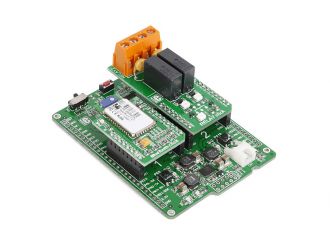
We strongly encourage users to use Package manager for sharing their code on Libstock website, because it boosts your efficiency and leaves the end user with no room for error. [more info]

Rating:
Author: MIKROE
Last Updated: 2016-02-18
Package Version: 1.0.0.0
Example: 1.0.0.0
Category: Bluetooth®
Downloaded: 1321 times
Followed by: 2 users
License: MIT license
This example demonstrates wireless Bluetooth switch control, using clicker2 for STM32, Bluetooth click board and Android smart phone.
Do you want to subscribe in order to receive notifications regarding "Bluetooth Switch" changes.
Do you want to unsubscribe in order to stop receiving notifications regarding "Bluetooth Switch" changes.
Do you want to report abuse regarding "Bluetooth Switch".
| DOWNLOAD LINK | RELATED COMPILER | CONTAINS |
|---|---|---|
| 1428580928_bluetooth_switch_mikroc_arm.zip [928.29KB] | mikroC PRO for ARM |
|

Front side appearance of the Clicker2 for STM32 with BlueTooth and Relay click boards.
View full imageClassic is always in style, but with this new Android app, Bluetooth click is even more appealing. Wherever you see IoT mentioned, there’s probably mention of BLE behind the corner. Is it time to forget about Bluetooth classic?
Of course not. You should definitely stay in the loop and try to learn as much as you can about emerging technologies, nobody argues against it. But don’t let the new and shiny blind you. It’s just as important for developers to recognise occasions that call for a more conservative approach.
A BLE module may require only a coin cell battery to run, but it will drain more energy from you as a developer. If power consumption is not critical, classic bluetooth is much simpler to work with. Specifically, Bluetooth click has a familiar UART interface, an on-chip antenna, and a fully qualified 2.1/2.0/1.1 RN41 module with built-in firmware.
Also, consider that the majority of consumers still don’t have BLE-enabled smartphones. If you’re developing some sort of hardware that’s meant to connect with phones or tablets, Bluetooth classic is still a safer bet if you want a bigger pool of potential users.
To simplify development on the smartphone side, we developed an Android app that pairs with Bluetooth click. It’s just a simple interface with two switches for setting things on and off with a relay (our hardware setup is based on a clicker 2 for STM32 board and on a relay click).
Examples are written for :
- Clicker 2 Board for STM32 - STM32F407VG